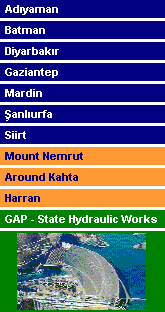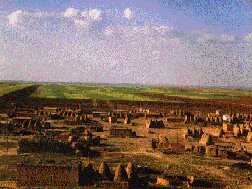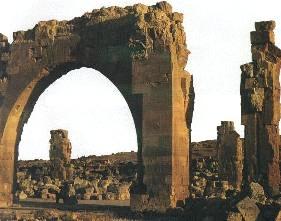| Harran... |
|
In the great plain of High Mesopotamia, Sanliurfa, known in ancient times first as Ur and later as Edessa, proudly exhibits
the legacy of all the civilizations that have prospered in this region. In the second millennium BC, it was a city of a
Hurrite state. Tradition relates that Abraham was born in a cave near where the Mevlid Halil Mosque now stands. Today the
cave is a pilgramage site and flocks of pigeons do not seem to disturb the elderly men praying around the entrance. The
remains of a castle with two Ione Corinthian columns rising above the ruined walls, stands atop a small crest. At the foot
of the hills, the lovely Halil Rahman Mosque is built around a quiet pool in which sacred carp swim. The 17th
century Ottoman Ridvaniye Mosque and the Firfirli Mosque, formerly the Church of the Apostles, are worth a detour. The
archaeological and ethnographical museum, one of the best in Republic of Türkiye, houses important Neolithic and
Chalcolithic finds from the Lower "Firat River" region. To capture the spirit of Sanli Urfa, wander through the vaulted
eastern bazaar and linger in the courtyards of the old hans (inns); try to find Gümrük Hani and Barutcu Hani - they are
the most interesting. Believed to be the ancient city of the same name mentioned in the Old Testament, Harran is known
more now for its unusual beehivedwellings than as the place where Abraham spent several years of his life. The archaeological
remains include those of the largest ancient Islamic University, city walls dating from the 8th century, four
gates and a citadel. The Gap project will transform Harran into one of the most fertile areas in Türkiye. So says the Bible
about Harran's most famous resident, who stayed here for a few years back in 1900 BC. It seems certain that Harran, now
officially called Altinbasak, is one of the oldest continuously inhabited spots on earth. Now its ruined walls and Ulu
Cami, its crumbling fortress and beehive houses give it a feeling of deep antiquity. Harran's ancient monuments are
interesting, though not really impressive. It is more the lifestyle of the residents that you may find fascinating. They
live by farming and smuggling and now await expectantly the completion of the "Atatürk Baraji" (dam) which will bring water
to the irrigation system under construction. Once the longed-for waters arrive, farming might actually become safer and
more profitable than smuggling. Besides Abraham's sojourn, Harran is famous as a centre of worship of Sin, god of the moon.
|
|

|







